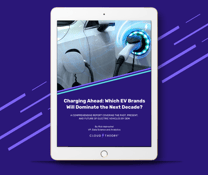Hybrid Vehicles Poised to Gain Market Share, Create Pathway to Meeting Auto Industry Environmental Goals as Regulatory Requirements, Dates Eased
Grand Rapids, Mich., April 29, 2024 – Changes in environmental regulatory requirements for the auto industry over the past six months have shifted focus from Electric Vehicles and created a pathway for Hybrid Vehicles to gain more market share. These changes also shift power away from EV leader Tesla to more Hybrid-focused OEMs.
The findings are part of ”Charging Ahead: Hybrids Come Into Sharper Focus as EV Aspirations Meet Reality” by Rick Wainschel, Vice President of Data Science and Analytics at Cloud Theory.
“Regulatory requirements and dates have eased, with the Biden Administration slashing EV adoption targets from 67% to 35% by 2032,” Wainschel said. “With that shift, OEMs have pulled back on their investments and reduced their EV scale and scope.”
Hybrids have been gaining in inventory share and market share for the past three years, and these changes will only add to momentum in this sector. In Q1 2024, year-over-year Hybrid share of vehicle movement jumped 3.2 percentage points, to 11.6% from 8.4% in Q1 2023. Electric Vehicle share (excluding Tesla and Rivian) grew only 1 percentage point from 2.6% in Q1 2023 to 3.6% in Q1 2024. Electric Vehicle inventories (5.5%) outpaced EV market share, indicating that there is still an oversupply imbalance that was driven by overproduction as OEMs had moved towards meeting the prior regulatory standards. Meanwhile, Hybrid inventory share was significantly less than market share in Q1 2024 (9.3%% vs. 11.6%), indicating that there is room to grow that sector further.
“The shift from a sustainable future focused on EVs to one balanced between EVs and Hybrids profoundly changes the competitive landscape,” Wainschel said. “Companies such as Toyota Motor Group, Hyundai Motor Group, Stellantis, Ford Motor Company and Honda Motor Company all have well-developed Hybrid lines and now have a more varied patch to achieve fuel economy goals and regulatory requirements.
This presents a challenge for EV-centric companies such as Tesla, Rivian and Polestar, which must contend for consumers--who have expressed reluctance to purchase EVs due to battery concerns, charging anxiety, and high purchase costs--with only an EV offering.
“The shift in regulatory focus gives traditional OEMs more options to meet government standards and to appeal to consumers,” Wainschel said. “Ford’s recently launched ‘Your vehicle, your choice’ campaign, for example, opens pathways that EV-specific rivals can’t follow. Trading gas-powered vehicle purchases for enough Hybrid replacements can help traditional OEMs extend regulatory demands and timelines even further, thereby reducing pressure to quickly and unprofitably introduce EVs.”
Download the full report and view an excerpt below.
Excerpt from: April 2024
Charging Ahead: Hybrids Come Into Sharper Focus as EV Aspirations Meet Reality
Cloud Theory has written and commented extensively about the electric vehicle market, most notably in our original “Charging Ahead” report, which was published in the Fall of 2023. That report identified the growing imbalance between growing EV supply—driven by aggressive regulatory requirements and timelines—and a stubbornly static demand picture.
We had always expected to return to this subject to analyze and comment on more recent events and category dynamics—perhaps once a year. But a funny thing happened on the way to the industry revolution. Aspirations—from the government, OEMs, infrastructure support, parts suppliers, and others —met the reality of the marketplace, and the revolutionary pendulum has swung back towards a more manageable evolutionary middle ground in very short order. Regulatory requirements and dates have eased, with the Biden Administration slashing EV adoption targets from 67% to 35% by 2032. With that shift, OEMs have pulled back on their investments and reduced their EV scale and scope.
Even at the lower 35% target level, these requirements ensure that EVs will play a more prominent role in future industry offerings and consumer choices going forward. However, the hyper-aggressive production levels and timeline driven by EPA regulations have given way to a more measured approach that reflects the current capabilities of manufacturers to produce these vehicles, as well as consumers’ comfort and financial realities in purchasing them.
Consumers Remain Skeptical About EVs But “Sustainability Minded”
Consumers have demonstrated a relatively widespread reluctance to embrace EVs, and demand has not kept pace with the increasing supply that previous regulatory standards had spurred. This has led to significant declines in turn rate and substantial increases in days-to-move over the past year. A recent McKinsey Study indicated that 42% of interested EV buyers do not intend to switch unless battery range and infrastructure improve, indicating that even those contemplating a move in that direction have skepticism that must be alleviated before more widespread adoption can occur.
With that said, consumers are generally open to eco-friendly options, with a recent Accenture Analysis revealing that 64% consider themselves “sustainability-minded” and would prefer their next vehicle to be an alternative to being gas-powered. This sentiment—coupled with the current obstacles in the EV space—positions OEMs with well-developed hybrid offerings to succeed until fully electric capabilities become more mature. With the regulatory picture currently shifting deadlines to reflect a more realistic future state, this interim window of time is already getting longer. And if there is a change in the White House in favor of the Republicans in 2024, it is almost certain that this timeline will stretch even further.
Hybrids Come Into Focus
After numerous CEOs’ bold pronouncements and optimistic forecasts regarding EVs reigned supreme in 2022 and 2023, more recent assertions have reflected a tempered view of the future state of sustainable vehicles and how OEMs will get there.
In an April 2024 media statement, for example, Ford Motor Company indicated that it is pursuing “the development of a differentiated and profitably growing EV business over time while [it] serves customers with the right mix of gas, hybrid and electric vehicles based on demand today. In parallel, Ford is expanding its hybrid electric vehicle offerings. By the end of the decade, the company expects to offer hybrid powertrains across its entire Ford Blue lineup in North America.” In support of this shift, Ford launched a new ad campaign focused on “your vehicle, your choice”, which focuses on how the company offers “a range of gas, hybrid, and electric products to suit almost every customer’s need.”
Meanwhile, General Motors CEO Mary Barra, who had previously declared that the company was fully committed to an electric vehicle future, has taken a more balanced position in 2024. Stating that GM plans to bring back plug-in hybrid technology to North America, Barra was quoted in the Detroit News as saying that GM was doing so “to help us comply with the more stringent fuel economy and tailpipe emission standards that are being proposed”. That reporting also pointed to “a reversal from GM’s focus on battery electric vehicles as it watches the pace of EV sales slow.”
Similarly, a CNN report pointed to a reversion back to Toyota’s hybrid focus after its CEO had strongly signaled a pivot towards EVs. “The Japanese company has done little to embrace a fully electric future, instead sticking firmly to its wildly popular hybrid cars.” According to that same report, “the company has been lobbying governments around the world to keep hybrids on the streets for decades to come” and promoting these vehicles as the centerpiece of a clean energy strategy.
There are many other examples of OEMs pursuing a more nuanced and balanced strategy than was being heralded less than a year ago, and it is safe to say that hybrid vehicles will act as a bridge to enable several to get to a greener and more sustainability-oriented future. And while EV innovation and production will continue to increase that segment’s presence in the marketplace, it is likely that hybrids will delay and dampen a larger move in that direction over the next decade.
These shifts put additional pressure on Tesla, which has already been faced with price reductions, executive departures, poor reviews of its Cybertruck, and concerns about the dilution of Elon Musk’s focus after his purchase of Twitter. Tesla’s stock price fell by one-third over the course of Q1 2024, and layoffs are now planned to reduce costs.
EVs and Hybrids – By the Numbers
Considering all of these cross-currents, today’s circumstances and trends reinforce the realities that are causing these dynamics to play out.
Vehicle movement continues to be dominated by gas-powered vehicles. While the share of (non-Tesla) sales accounted for by ICE vehicles is down by 4.5 points on a year-over-year basis, it remains above 80%. And while other fuel types are picking up this lost share, it is hybrid vehicles (+3.2 share points) that are seeing gains more so than EVs (+1.0 share point).

In terms of the balance between inventory share and movement share, EVs have been in an oversupply situation since the beginning of 2023 when the former started to outpace the latter. Hybrids, meanwhile, have demonstrated that there is room to grow supply to meet an increasing demand scenario, as movement share of these vehicles has consistently outpaced inventory share over the past three years. A recent AP article stated that “buyers are increasingly embracing a quarter-century-old technology whose popularity has been surging” because of more affordable prices and without the EV anxiety related to charging logistics and battery capabilities.


Move Towards Hybrids Shifts Competitive Landscape
The pace of EV introductions and aggressive production, meanwhile, has slowed. The number of models that have average inventory levels of 1,000 or more stood at 33 in Q1 2024. While this is the highest number to hit that milestone to date, the pace of that growth slowed considerably over the past year.
The shift from a sustainable future focused on EVs to one that is more balanced between EVs and hybrids profoundly changes the competitive landscape. OEM parent corporations such as Toyota Motor Corporation, (which has by far the strongest hybrid lineup), Hyundai Motor Group (which has a well-developed lineup in both sectors), Stellantis, Honda Motor Company, and Ford Motor Company (which all have well-developed hybrid lines) now have a more varied path to achieve fuel economy aims and meet regulatory requirements by replacing gas-powered vehicles with tried-and-true hybrid technologies. As noted, General Motors plans to get back into the hybrid game, which will open up options for that company as well.
In general, the relaxing of regulatory requirements improves the competitive position of these companies relative to EV-centric players like Tesla, Rivian, and Polestar, which must contend with consumer concerns from a singular direction.



To view model trends and dynamics of EV models with Q1 inventory counts of 1,000 or more, you can download the full report below.





